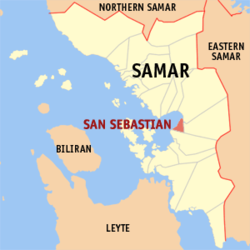San Sebastian | |
|---|---|
| Municipality of San Sebastian | |
 Map of Samar with San Sebastian highlighted | |
Location within the Philippines | |
| Coordinates: 11°42′N125°01′E / 11.7°N 125.02°E | |
| Country | Philippines |
| Region | Eastern Visayas |
| Province | Samar |
| District | 2nd district |
| Named after | San Sebastián, Spain |
| Barangays | 14 (see Barangays) |
| Government | |
| • Type | Sangguniang Bayan |
| • Mayor | Endi Gaviola |
| • Vice Mayor | Laleine N. Babon |
| • Representative | Reynolds Michael Tan |
| • Councilors | List |
| • Electorate | 7,746 voters (2025) |
| Area | |
• Total | 39.07 km2 (15.09 sq mi) |
| Elevation | 8.0 m (26.2 ft) |
| Highest elevation | 187 m (614 ft) |
| Lowest elevation | 0 m (0 ft) |
| Population (2024 census) [3] | |
• Total | 9,110 |
| • Density | 230/km2 (600/sq mi) |
| • Households | 1,968 |
| Economy | |
| • Income class | 6th municipal income class |
| • Poverty incidence | 26.91 |
| • Revenue | ₱ 89.56 million (2022) |
| • Assets | ₱ 252.8 million (2022) |
| • Expenditure | ₱ 64.3 million (2022) |
| • Liabilities | ₱ 36.21 million (2022) |
| Service provider | |
| • Electricity | Samar 2 Electric Cooperative (SAMELCO 2) |
| Time zone | UTC+8 (PST) |
| ZIP code | 6709 |
| PSGC | |
| IDD : area code | +63 (0)55 |
| Native languages | Waray Tagalog |
San Sebastian, officially the Municipality of San Sebastian (Waray : Bungto han San Sebastian; Tagalog : Bayan ng San Sebastian), is a municipality in the province of Samar, Philippines. According to the 2020 census, it has a population of 8,704 people. [5]
Contents
San Sebastian was absorbed into the town of Wright (Paranas) during the American occupation. In 1950, the neighborhoods of San Sebastian, Jitaasan, Dolores, Camanjagay, Bontod, Campidasa, Campiyak, Maslog, Balogo, Maropangpang, Binongtoan, and Bolwan were combined and re-established as a single town. [6]



